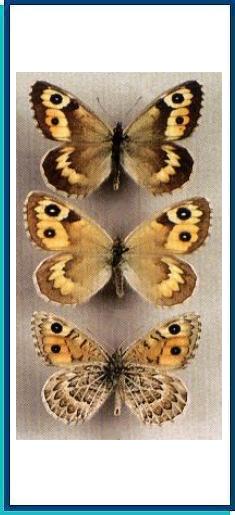LEPIDOPTERA
S A T Y R I D A E Boisduval, 1833
KARANASA Moore, 1893
Karanasa incerta Bogdanov 1997
Karanasa incerta Bogdanov 1997

· DESCRIPTION. Male (holotype). FW length 21 mm (18-22 mm in the series). FW greatly produced, apex pointed. UPS ground colour dark brown, sometimes with light yellowish suffusion. Base of wing and costal area lightened, especially in cell, which can be whitish in the costal part. Postdiscal band contrasting, sharply outlined, with its outer margin intensively dentate and the inner margin even, noticeably narrowed along vein M3; its colour is generally tawny-yellow, varying from ochreous-brown to pale yellow or whitish, always paler at costa and apical ocellus. Ocelli large, black, always centred with a small dazzling white dot (with the exception of one male which has both ocelli blind), the apical ocellus always being considerably larger than the anal one. Fringes greyish, intensively darkened at ends of veins by dark brown ground colour and divided throughout by a fine dark brown line, which makes them look double. HW rounded; UPH dark brown, lightened yellowish at base and along dorsum. Postdiscal band strongly dentate outwardly, its inner margin even, though always with a well-defined tooth along vein M3; the colour of the band is basically ochreous-yellow but varies from bright tawny-red to whitish-yellow, and sometimes is paler along the inner margin. The area between the band and margin slightly dusted yellowish along veins. Fringes whitish, paler than on FW and practically not chequered at veins, also looking double. Androconial scales wanting.
The male genitalia are similar to those of K. decolorata and K. josephi and seem to have no diagnostic importance.
Female. FW length 22.0-23.5 mm. FW produced, apex rounded. Wing pattern and ground colour as in male, but wing bases always more lightened, the pale area never touching postdiscal band. Ocelli bright and large, always white-centred. UPH and fringes as in male. UNS pattern in both sexes similar to that of all other Karanasa species; markings of upperside can be traced on UNF. Antennae brown above, whitish beneath; club dull brown. Head, thorax and abdomen brown like wings, covered with yellowish hairs.
· RANGE. Confined to the Pamirs.
· HABITAT AND BIOLOGY. Stony and clayey steppe-clad slopes at 3,400-4,600 m a.s.l. Flight period: July-August. Often flying together with K. alpherakyi and K. bolorica, in the eastern part of the range (Pass Koitezek) also with K. leechi.
· SIMILAR SPECIES. K. straminea: larger; fringes pale. K. bolorica: male FW with an androconial area; UPF apical ocellus reduced or absent, as a rule; FW produced and apex pointed. K. alpherakyi: larger; UPF ocelli without white pupils, as a rule. K. leechi: UPS markings paler and less strongly contrasting; UPS postdiscal band inwardly diffused. K. decolorata grumi: larger; UPS markings less strongly contrasting; males with an androconial area.
Photo and text: Guide to the BUTTERFLIES OF RUSSIA and adjacent territories Volume 1. PENSOFT, Sofia - Moscow. 1997